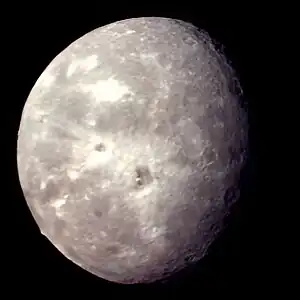
Oberon is the outermost major moon of the planet Uranus. It is the second largest and second most massive of Uranian moons, and the ninth most massive moon in the Solar System. Discovered by William Herschel in 1787, Oberon is named after a character in Shakespeare's A Midsummer Night's Dream. Its orbit lies partially outside Uranus's magnetosphere. Oberon consists of approximately equal amounts of ice and rock, and is likely differentiated into a rocky core and an icy mantle. A layer of liquid water may be present at the core/mantle boundary. The surface of Oberon, which is dark and slightly red in color, appears to have been primarily shaped by asteroid and comet impacts. It is covered by numerous impact craters reaching 210 km in diameter. Oberon possesses a system of canyons (scarps) formed as a result of the expansion of its interior during its early evolution. This moon probably formed from the accretion disk that surrounded Uranus just after the planet's formation. As of 2010, the Uranian system has been studied up close only once: by the spacecraft Voyager 2 in January 1986. It took several images of Oberon, which allowed mapping of about 40% of the moon’s surface. (Full article...)